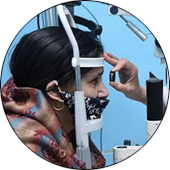- Email: Sushil_60@yahoo.com
- 4/15, sector -5, rajendra nagar
- Call: +91 98100 32030
About Us

20
Years of Experience in This Field
The Great Place Of New Vision Eye and Medical Care. Best Eye Care Clinic in Ghaziabad.
"The Great Place Of New Vision Eye and Medical Care" is the premier Eye Care Clinic in Ghaziabad, dedicated to providing top-notch medical and eye care services to the community. Our mission is to offer comprehensive, compassionate, and state-of-the-art eye care to improve the vision and overall well-being of our patients.
Our Mission
- High-quality work
- Innovation and Research
- Rapid response times
Our Vision
- Best Price
- Best Treatment
- Emergency solutions
How Harmful is Tuberculosis?
Tuberculosis (TB) is a bacterial infection caused by Mycobacterium tuberculosis. It
primarily affects the lungs but can also impact other parts of the body. The severity and
harm of tuberculosis can vary depending on several factors, including the individual's
overall health, the strain of the bacteria, and the timeliness of diagnosis and treatment.
Here are some key points to consider:
1. Infection vs. Disease: Not everyone exposed to the tuberculosis bacterium
becomes
sick. In many cases, the immune system can control the infection, leading to latent
tuberculosis, where the bacteria are present but not causing active disease. Latent TB is
not contagious, and the individual does not exhibit symptoms.
2. Active Tuberculosis: Active tuberculosis occurs when the bacteria multiply and cause disease in the body. This is the form of TB that is associated with symptoms, such as persistent cough, fever, night sweats, and weight loss. Active TB can be quite harmful and, if left untreated, can be fatal.
3. Transmission: TB is primarily spread through the air when an infected person with active TB coughs or sneezes. It is contagious, but not everyone exposed to the bacterium will develop the disease. Factors such as the duration and proximity of exposure, the individual's immune system, and other health conditions can influence whether the infection progresses to active disease.

Severity: The severity of active TB can vary from mild to severe. Some individuals may have a relatively mild form of the disease, while others can develop more severe and life-threatening complications.
Treatment: TB is treatable with antibiotics, usually a combination of drugs taken for several months. With appropriate treatment, the majority of individuals with TB can be cured. However, treatment adherence is crucial to prevent the development of drug-resistant strains.
Drug-Resistant TB: Some strains of tuberculosis have developed resistance to common TB medications. Multidrug-resistant TB (MDR-TB) and extensively drug-resistant TB (XDR-TB) are more difficult to treat and can be more harmful because the available treatment options are limited.
Impact on Vulnerable Populations: TB disproportionately affects vulnerable populations, such as individuals with weakened immune systems (e.g., those with HIV/AIDS), people living in crowded and unsanitary conditions, and those with limited access to healthcare. In these groups, TB can be more harmful and can spread more easily.
In summary, tuberculosis can range from latent infection, which is not harmful, to active disease, which can be quite harmful and even life-threatening if left untreated. The harm associated with TB is also influenced by factors like drug resistance, overall health, and access to healthcare. Early diagnosis and appropriate treatment are critical in preventing the progression of the disease and its harmful effects. TB is a significant global health concern, but with proper management, it can be controlled and even eliminated in some regions.
A Global Leader, Treatment
of eye Disease

Heart Disease
Heart disease, also known as cardiovascular disease, refers to a group of conditions that affect the heart and blood vessels. It can encompass various disorders such as coronary artery disease, heart failure, arrhythmias, and valvular diseases.

Pediatric Ophthalmology
Pediatric ophthalmology is a medical specialty focused on the diagnosis and treatment of eye and vision problems in children, from infancy to adolescence.

Lenses Transitions
Transition lenses are a type of eyeglass lens that automatically adjusts their tint in response to changing light conditions. They darken when exposed to UV light and become clear indoors.
How it Helps You to
Keep Healthy

Get Appointment
+91 98100 32030

Start Check-Up
Begin Your Journey to Better Health Today: Start Your Check-Up!

Enjoy Healthy Life
Embrace Wellness: Enjoy a Healthier Life!
What are The Symptoms of Tuberculosis?
The symptoms of tuberculosis (TB) can vary depending on the type of TB and the stage of the disease. The most common form of TB is pulmonary TB, which affects the lungs. Here are the typical symptoms of pulmonary TB:
1. Persistent Cough: A cough that lasts for three weeks or longer is one of the most common symptoms of pulmonary TB. The cough may produce sputum (mucus or phlegm), which can sometimes be bloody.
2. Chest Pain: Some individuals with pulmonary TB may experience chest pain, which can be sharp and located in the chest wall.
3. Coughing Up Blood: Hemoptysis, or coughing up blood, can occur in some cases of pulmonary TB.
4. Fever: Many people with TB experience a low-grade fever, often in the afternoon or evening.
5. Night Sweats: Profuse night sweats that drench the person's pajamas or bedsheets can be a symptom of TB.
6. Fatigue: Unexplained and persistent fatigue or weakness is common in people with active TB.
7. Weight Loss: Unintentional weight loss and a loss of appetite are common in individuals with active TB.
8. Chills: Some people may experience chills and shivering.

9. Loss of Appetite: A decreased or complete loss of appetite is a common symptom of TB.
10.Breathing Difficulties: As the disease progresses, individuals may have difficulty breathing and shortness of breath.
It's important to note that not everyone with TB will experience all of these symptoms. Some individuals may have only a few mild symptoms, while others may have a combination of more severe symptoms. Additionally, TB can affect other parts of the body, leading to different symptoms. For example, extrapulmonary TB can affect organs like lymph nodes, bones, joints, kidneys, and more, resulting in a wide range of symptoms related to the specific organ involved.
If you or someone you know is experiencing symptoms suggestive of TB, it's crucial to seek medical attention promptly. TB is a treatable disease, and early diagnosis and appropriate treatment are essential for a successful recovery and to prevent the spread of the disease to others.

